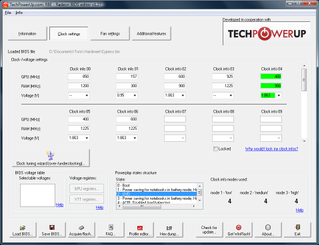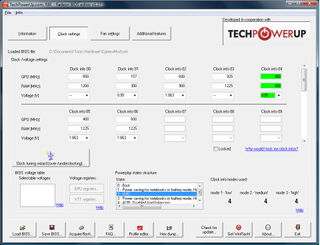Curbing Your GPU's Power Use: Is It Worthwhile?
In many cases, the graphics card is the most power-hungry component in a PC. The enthusiast community is no stranger to CPU tweaking, so why hasn't GPU modification caught on? We're going to see just how much you stand to gain (or lose) from tweaking.
The First Experiment: AMD’s Radeon HD 5870
The First Experiment: AMD’s Radeon HD 5870
First, we tried our luck with a Radeon HD 5870. However, we quickly noticed something odd. When we changed clocks, the operating voltage also changed. The resulting setting (1.125 V) is actually higher than the default voltage at the card’s default clock speed (1.063 V). In addition, idle clock speeds also changed. Power measurements show the card using more power at idle with these changes.
At first we blamed the utility we were using. So, we tried several different utilities, such as the Overdrive tab in AMD’s Catalyst Control Center, the company’s own GPU Clock Tool, and even third-party utilities like ATI Tool and Afterburner. No dice.
So, we decided to tackle this the hard way: by modifying the card’s BIOS to force our clock settings. To limit the chances of failure, leaving us with a non-functional card, we only changed clock settings for UVD mode. One thing we noticed while testing the Radeon HD 5870 was that its core and memory clocks stay constant when UVD is active. This behavior is applicable to most AMD graphics cards. Now we have a makeshift intermediary P-state for GPUs.
We need to remind you that running your graphics card outside of the vendor's specification is considered overclocking, thus voiding your warranty. Overclocking can cause crashes, system instability, data loss, and even permanent hardware damages. If you choose to do so, continue at your own risk.
Performing The Operation
Before we begin, there are some preparations in order. Although we’re making limited modifications to the UVD clock settings, there's still a chance something could go wrong. Since we don't have any PCI graphics cards to fall back on in case of a bad flash, we have to rely on the AMD 790GX’s integrated graphics engine. This turned out to be a good choice, since the flash tools weren't able to flash its BIOS.
Stay on the Cutting Edge
Join the experts who read Tom's Hardware for the inside track on enthusiast PC tech news — and have for over 25 years. We'll send breaking news and in-depth reviews of CPUs, GPUs, AI, maker hardware and more straight to your inbox.
We extracted the Radeon HD 5870’s BIOS with GPU-Z and loaded it into Radeon BIOS Editor (RBE).

A look at the clock settings in RBE revealed some interesting facts. There are two options listed in the voltage drop-down list: 0.95 V and 1.063 V. This means we can try to undervolt the card as well.

We ran several tests at the default clocks and voltage (400/900 MHz @ 1.063 V), along with two undervolted settings (400/900 and 600/900 MHz @ 0.95 V). For reference purposes, we also ran the tests at full clocks and voltages (925/1225 MHz @ 1.063 V), then added results from a Radeon HD 5770 and HD 5670. Both mainstream cards were running at their default clocks, too.
We chose 600 MHz because power consumption numbers measured at this setting are similar to default UVD clock and voltage. Memory clock settings were left untouched, because higher frequencies require more voltage and lower clocks may introduce screen flickering.
Current page: The First Experiment: AMD’s Radeon HD 5870
Prev Page Test System Next Page Benchmark Results: Cinebench R11 And PowerDirector 9-
I think, considering those people using SLi and crossfire and higher end videocards, they don't really give a gat about how much elec. they are using. They can afford to buy two expensive PCBs, why would they care about extra 5~10 bucks per month? If poeple are focused on lower power consumption, they would go for lower performance components, arent they?Reply
-
anttonij I guess the most important point of this review is that you can lower the cards voltage while running at stock speed. For example I'm running my GTX 460 (stock 675/1800@1.012V) at 777/2070@0.975V or if I wanted to use the stock speeds, I could lower the voltage to 0.875V. I've also lowered the fan speeds to allow the card to run almost silently even at full load.Reply -
Khimera2000 @.@ there is no apple @.@Reply
This is neat though :) I wonder if this article might inspire someone to make an application. Come on open source dont fail me now >. -
Could you do comparison of "the fastest VC" vs "entry level" and then show us how much money we might end up paying each month or day?Reply
-
the_krasno Manufacturers should find a way to implement this automatically, imagine the possibilities!Reply -
wrxchris @OvaCerReply
I have 2 gfx cards pushing 3 displays, but I'm all for saving watts wherever I can. Our society has advanced to the point where sustainability is a very important buzzword that is widely ignored by mainstream media and many corporations, and this ignorance trickles down to the mainstream like Reaganomics. Minuscule reductions such as 30w savings across hundreds of thousands if not millions of users adds up to a significant reduction in carcinogenic emissions and saves valuable resources for future consumption. -
neiroatopelcc So when playing video, you risk your amd card going into uvd mode? What models does that apply to?Reply
I want to know, cause for instance in a raid, I'd sometimes watch video content on another screen while waiting around for whatever there is to wait for. I already lose the crossfire performance because of window mode. I don't want to lose even more.
Does my ancient 4870x2 support uvd? -
jestersage so... for the dual bios HD6900s, I can RBE one bios with my desired settings and just choose which bios to use before I power up my PC? hmmm... interesting.Reply
Most Popular

